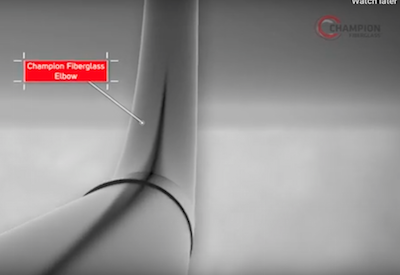How Data Centres Benefit from Fiberglass Conduit Elbows

Aug 28, 2019
Data centres are vital elements of our modern world, securely facilitating delivery of the most valued commodity today, our data. They house assorted bandwidth-intensive devices, like blade servers, storage systems, virtualization appliances and backup devices connected by a significant volume of networked cabling and electrical wiring.
Characteristics like lack of burn-through, low coefficient of friction, and fault resistance make fiberglass conduit elbows an ideal solution to protect data centre infrastructure. Moreover, fiberglass conduit is cost effective, lighter, easier to handle and transport, and less labour intensive to install than traditional alternatives.
Everyday digital
Our world is increasingly digital with bits and bytes converging with real life tasks constantly. As reliance on the Internet of Things (IoT) surges, activities are increasingly dependent on data centres as they handle mission-critical data and processes for business, government and organizations.
In designing data centres, the goal is to preserve and secure technology infrastructure while addressing future scalability. Electrical considerations like wire, cable, conduit and planning are fundamental components of data centre projects, and some of the more expensive aspects. On Backblaze.com, Roderick Bauer notes, “Electrical power usually represents the largest cost in a data centre.”
Cost containment protection of the massive amount of wire and cable from elbow burn-through during installation and faults after installation is essential to preserve investment, so electrical conduit deserves careful consideration. Securing data centre components begins from the ground up in facility design. Best practices dictate durable, cost-efficient fiberglass electrical conduit elbows.
It’s what’s underneath that counts
Electrical conduit is typically buried in trenches, and sometimes the conduit is placed in concrete banks that shield the wire and cable from elements like weather, fire, even animals.
Conduit elbows are integral to bringing subterranean wire and cable to surface and upper levels of data centres. As data centre design maximizes server space, fiberglass conduit elbows must support an increasing amount of heavy cable while minimizing burn-through for this dense environment.
Fiberglass elbows offer next-level protection for data centres
Of all conduit products available, fiberglass conduit elbows offer strategic advantages in data centre builds because of lack of burn-through, low coefficient of friction, and fault resistance to properly protect data centre assets. And fiberglass conduit’s corrosion resistance and cost savings add to its appeal.
Here’s why fiberglass conduit is the best solution to conserve data centre assets:
• Burn-through does not occur with fiberglass conduit elbows. Elbow burn-through compromises the conduit and cable system integrity and often results in increased labour and material costs. Fiberglass conduit elbows eliminate burn-through, leaving strong, durable, conduit that protects data centre cables.
• Fiberglass conduit elbows possess one of the lowest coefficients of friction of any conduit system. Fiberglass conduit’s coefficient of friction measures .38 compared to .55 for PVC-coated steel and galvanized rigid steel and .90 for SCH 40 and SCH 80 PVC. Fiberglass conduit’s low coefficient of friction allows for longer conduit runs with fewer pull boxes. This enables a faster, smoother pull with less labour time, cost and risk. Additionally, cable pulling lubricants have no detrimental effects on fiberglass conduit.
• Fault resistance in fiberglass conduit elbows creates long-term protection for data centres. Continuous power is necessary to sustain data centre operation. Fault resistance ensures cable will not melt the fiberglass conduit or weld the cable to the conduit, allowing wire to be easily pulled through, without a costly repair to the conduit.
Cost savings of fiberglass conduit elbows appeal to data centre designers
Because of its light weight and easy installation, the cost savings associated with the installation of fiberglass conduit is significant. Lighter weight suggests easier and less expensive handling and transport in some cases. Additionally, installation requires fewer labour hours as outlined in the NECA manual of labour units (MLU), so labour costs are lower. Due to its durability and corrosion resistance, fiberglass conduit lasts longer, so the overall cost of installed fiberglass conduit over time is typically less than other conduit products on the market.
Protect hi-tech with an innovative conduit solution
Technology companies recognize the innovation behind fiberglass conduit as a solution that protects their cable and wire, secures data and preserves data centre investment. In-the-know engineers, project owners and contractors depend on fiberglass elbows’ ability to withstand cable burn-through, tolerate electrical faults and guard against underground corrosion. Data centre designers appreciate the cost efficiency of the product and its installation. For data centres, fiberglass elbows offer a durable, cost efficient product companies can trust to safeguard assets.
This white paper was first published online by Champion Fiberglass; https://championfiberglass.com/application/data-centres/
















